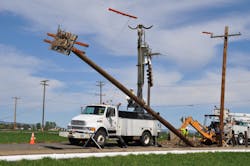Mitigating Bird Nesting on Distribution Poles
For decades, utilities have made great strides in taking steps to reduce the impact of their infrastructure on birds. An increasing number of utilities are implementing avian protection programs, refining their methods, and using real-world experience to work towards more effective solutions.
PSE serves approximately 1.2 million electric customers and 900,000 natural gas customers across its 6,000-square-mile service area, which stretches across 10 Washington counties, primarily in the Puget Sound region. One of the most commonly encountered bird issues on PSE’s system is osprey nesting. Each year, a number of osprey nests are built on PSE’s equipment, including distribution poles, transmission structures, and cellular equipment on PSE poles. Nests on transmission structures are a mainly a nuisance during the nesting season due to restrictions for working around the protected nests, but nests on distribution poles, particularly those with equipment, can pose risk of outage, bird electrocution, and fire.
PSE follows the following steps for each problem nest identified on a PSE structure:
- Project planning and Engineering – coordinate with PSE Engineers and Contract (Potelco) to design, schedule, and secure materials for the project.
- Identify an alternate location in coordination with PSE Real Estate and landowners.
- Notify State and Federal Wildlife Agencies, mainly so they are prepared in case they receive notifications from the general public.
- Seek opportunities for partnership with local interest groups such as Audubon Society to collaborate on pole location and platform design and preparation, and for outreach opportunities/positive public perception.
- Work with the crew to assemble the platform and add nest material. The crew attaches two crossarms to the top of the pole, to which they attach a wooden pallet. The avian biologists and crew work together to secure sticks to the platform.
- Install the pole – the crew sets the pole with the platform attached. If the entire nest needs to be/can be relocated, the nest is then moved to the pallet once the pole is in place.
- Install nest deterrents on the original nest pole. PSE uses padmount markers and evaluate nearby poles for electrocution risk, install avian protection materials as needed to reduce the risk of the adult or fledgling electrocution.
- Monitor the nest for use and maintain as needed over time
- Add the nest location and information to the GIS avian tracking database
- Include information in the annual reports to U.S. Fish and Wildlife Service and Washington Department of Fish and Wildlife consistent with the permits under state and federal wildlife protection regulations.
Haley Olson is a Senior Resource Scientist with Puget Sound Energy, and in her 15 years with PSE, has become an expert in the field of avian protection. While working in this role, in addition to responding to and mitigating bird and power line incidents, Haley has developed informational materials; spearheaded efforts to adopt new technology to assist with incident tracking, risk assessment, and proactive efforts; supports avian management and habitat work at PSE’s wind and hydroelectric generation facilities; and provides internal training to improve the efficacy of the program.
Outside of PSE, Haley has contributed to industry standard-setting publications and assisted with providing industry workshops nation-wide with the Avian Power Line Interaction Committee. Her background includes a BS in Environmental Studies and English (Creative Non-fiction Writing), and several years of technical field work, including songbird nest surveys; spotted owl nest surveys, capture, and banding; marbled murrelet nest and habitat studies; and habitat restoration. When she’s not working, Haley enjoys spending time in nature with her young daughter.
About the Author
Haley Olson
Haley Olson is a Senior Resource Scientist with Puget Sound Energy, and in her 15 years with PSE, has become an expert in the field of avian protection. While working in this role, in addition to responding to and mitigating bird and power line incidents, Haley has developed informational materials; spearheaded efforts to adopt new technology to assist with incident tracking, risk assessment, and proactive efforts; supports avian management and habitat work at PSE’s wind and hydroelectric generation facilities; and provides internal training to improve the efficacy of the program.
Outside of PSE, Haley has contributed to industry standard-setting publications and assisted with providing industry workshops nation-wide with the Avian Power Line Interaction Committee. Her background includes a BS in Environmental Studies and English (Creative Non-fiction Writing), and several years of technical field work, including songbird nest surveys; spotted owl nest surveys, capture, and banding; marbled murrelet nest and habitat studies; and habitat restoration. When she’s not working, Haley enjoys spending time in nature with her young daughter.



